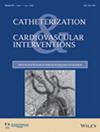Outcomes of transcatheter closure for coronary artery fistulas with or without aneurysm: A comparative study
Abstract
Background
Coronary Artery Fistulas (CAFs) Patients with aneurysm may face severe complications, necessitating prompt treatment. However, data on the outcomes of transcatheter closure in CAFs patients with aneurysm are notably scarce.
Methods
This retrospective study included all consecutive CAFs patients who underwent transcatheter closure at Fuwai Hospital from January 2010 to December 2023. Patients were divided into two groups based on the presence of aneurysm, and baseline characteristics, anatomical features, and transcatheter closure outcomes were further compared.
Results
The study ultimately included 104 patients, consisting of 56 in the aneurysm group and 48 in the non-aneurysm group. Patients in the aneurysm group were younger [39.79 (16.35) versus 50.69 (13.31) years, p < 0.001] and more frequently present with heart murmurs (21.43% vs. 6.25%, p = 0.03). Multivariate logistic regression indicated that a larger fistula diameter and the presence of CCFs are independent risk factors for the presence of aneurysm in CAF patients. The procedural success rate (75% vs. 75%, P = 1), fistula recanalization rate (11.11% vs. 16.67%, p = 0.42), and reintervention rate (3.7% vs. 6.25%, p = 0.89) were similar between the aneurysm and non-aneurysm groups.
Conclusion
A larger fistula diameters and the presence of coronary-cameral fistulas are independent risk factors for the occurrence of aneurysms in patients with CAFs. The outcomes of transcatheter closure are comparable for CAFs patients with and without aneurysm, though post-closure thrombosis within the fistula appears to be more common in patients with aneurysm.

 求助内容:
求助内容: 应助结果提醒方式:
应助结果提醒方式:


